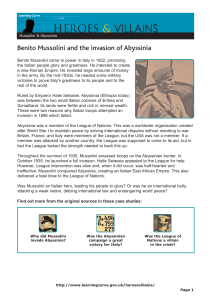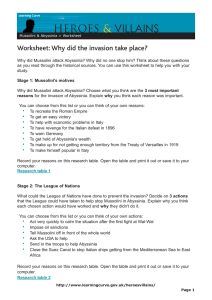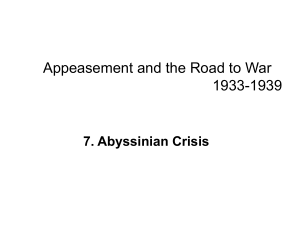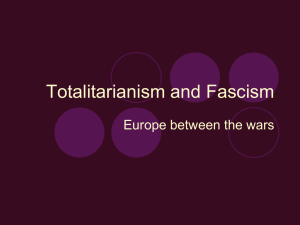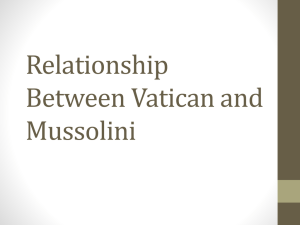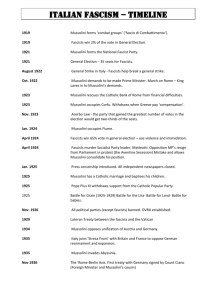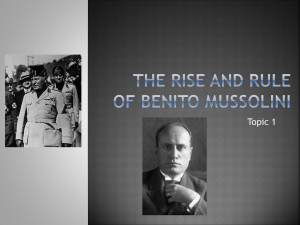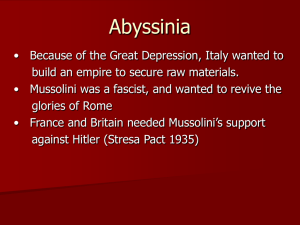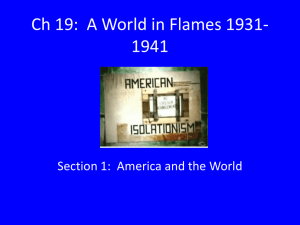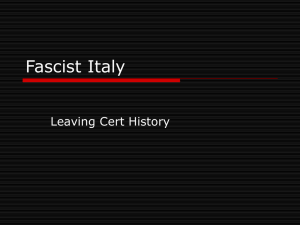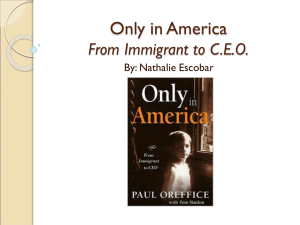Mussolini`s Foreign Policy
advertisement
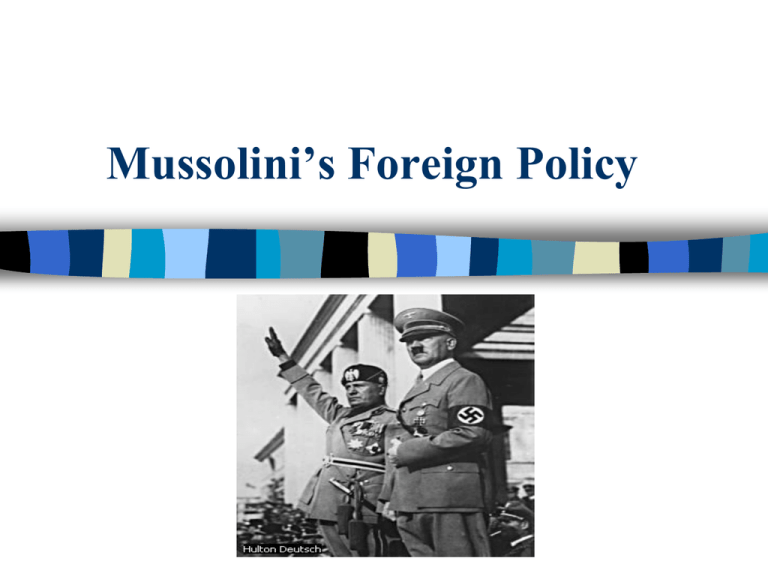
Mussolini’s Foreign Policy Likely Essay Questions on F.P Success and failure of F.P Examine the global impact of one ruler of a single-party state. Analyse the foreign policy of two rulers of single-party states, each chosen from a different region. Summary of Italy under Mussolini Stage 1 1922-24 Consolidation Stage 2 1924-28 Dictatorship Stage 3 1929-35 Consensus Stage 4 1936-45 Radicalisation and Collapse Key Issues Identify Mussolini’s F.P aims Build up a detailed timeline of events from 1922-1935- 1939 -1945 What was the significance of the Abyssinian War? What was the significance of the relationship between Mussolini and Hitler? How successful was Mussolini’s F.P? What were Mussolini’s F.P aims? National power and prestige- Italy’s image abroad To support domestic policy To build support from Italians for the regime Establishment of an Empire ‘place in the sun’ Dominance in the Balkans / Mediterranean (Mare Nostrum) (Italian Lake) Italy as a ‘makeweight’ power The International SituationItaly and the rest of the world Legacy of World War One- Paris Peace conference. League of Nations USSR / USA isolationism Germany However 1920s a period of ‘relative’ calm Italian Foreign Policy 19221935 Until 1935, Mussolini conducted a foreign policy which was quite cautious and usually aimed to be respectable. Key policy actions referred to: 1. 2. 3. 4. 5. 6. 7. Fiume Corfu Albania Libya The frontier with Austria The Locarno Pacts The Four Power Pacts Task: Create a table to illustrate Mussolini’s actions in relation to the above issues. When did they happen? What did they involve? What was Mussolini's role? How did they reflect on Mussolini? Key Issues- 1922- 1935- ‘all noise and bluster’ Prior to WWI- Italy had established empire in Libya, Eritrea and Somaliland. Italy as a power ‘on the rise’- if you believe the propaganda. Locarno- spirit of optimism- the ‘Locarno Honeymoon’. Nothing concrete achieved. Western borders agreed for Germany. Corfu and Fiume- minor achievements overplayed by Mussolini- propaganda of the ‘great nation’. Four Power Pact- alternative to the LON. Nothing concrete achieved. The failed ‘Anschluss’ in Austria 1934- Hitler was testing how aggressive he could be at this point. Mussolini fires a ‘warning shot’ by sending troops to the Austrian border. Stresa Front- signals attempts by UK and France to tame Hitler- led to problems in Africa (Abyssinia) Abyssinia Origins of the war in Abyssinia Military- Battle of Adowa 1896 Political-Italy’s ‘place in the sun’ Economic-Resources- raw materials esp oilthe search for autarky Political / Social- diverted attention away from Depression - failed economic policies International / Political- all this must be set in the context of increasing aggression- Japan in Manchuria / Hitler coming to power in Germany- failure of the League of Nations to curb aggression (collective security) Causes and key features December 1934- Border clash over the disputed Wal Wal oasis. February 1935- Italian troops sent to Italian East Africa. April 1935 Stresa Front meeting between UK, France and Italy appears to signal agreement over Italian interests in Abyssinia. October 1935 Italian Invasion of Abyssinia League of Nations declares the invasion ‘aggressive’- limited sanctions imposed on Italy Key Features December 1935- secret ‘Hoare-Laval Pact’ (French / UK) plans to give Italy half of Abyssinia- the plan is leaked to the press and then withdrawn. May 1936 - formal annexation of Abyssinia by Italy- League sanctions withdrawn soon after. Consequences Economic- budget deficit- 16 billion lire / devaluation in the economy Economic / Military- 1/4 million troops needed to be stationed in Abyssinia International / Political- Failure of League of Nations to stop aggression- also pushed Mussolini into axis with Germany
